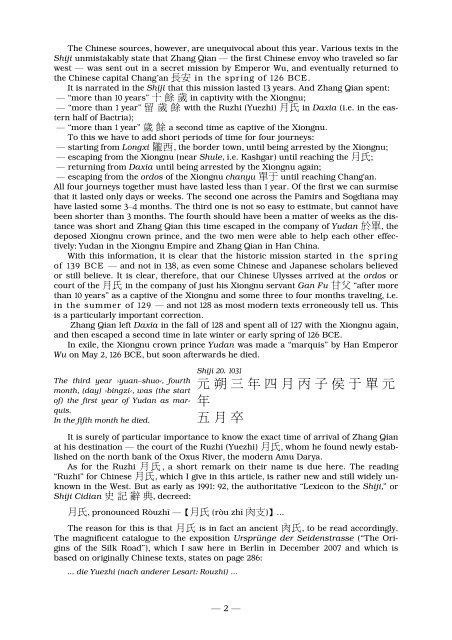張騫 Zhang Qian. The Secret Envoy of Han Emperor Wu in Search of the Arsi (Yuezhi) and the Fall of the Græco-Bactrian Kingdom. (Annotated Compilation of Eastern and Western Sources)
The study undertakes: — to clarify in what year Zhang Qian reached the Oxus river; to establish that the Daxia 大夏 in Shiji 123 represent the Tachar/Tochar of Tochar-i-stan; to explain how we are to understand the "List of Four" in Strabon 11.8.2.
The study undertakes: —
to clarify in what year Zhang Qian reached the Oxus river;
to establish that the Daxia 大夏 in Shiji 123 represent the Tachar/Tochar of Tochar-i-stan;
to explain how we are to understand the "List of Four" in Strabon 11.8.2.
Create successful ePaper yourself
Turn your PDF publications into a flip-book with our unique Google optimized e-Paper software.
<strong>The</strong> Ch<strong>in</strong>ese sources, however, are unequivocal about this year. Various texts <strong>in</strong> <strong>the</strong><br />
Shiji unmistakably state that <strong>Zhang</strong> <strong>Qian</strong> — <strong>the</strong> first Ch<strong>in</strong>ese envoy who traveled so far<br />
west — was sent out <strong>in</strong> a secret mission by <strong>Emperor</strong> <strong>Wu</strong>, <strong>and</strong> eventually returned to<br />
<strong>the</strong> Ch<strong>in</strong>ese capital Chang ’an 長 安 <strong>in</strong> <strong>the</strong> spr<strong>in</strong>g <strong>of</strong> 126 BCE.<br />
It is narrated <strong>in</strong> <strong>the</strong> Shiji that this mission lasted 13 years. And <strong>Zhang</strong> <strong>Qian</strong> spent:<br />
— “more than 10 years” 十 餘 歲 <strong>in</strong> captivity with <strong>the</strong> Xiongnu;<br />
— “more than 1 year” 留 歲 餘 with <strong>the</strong> Ruzhi (<strong>Yuezhi</strong>) 月 氏 <strong>in</strong> Daxia (i.e. <strong>in</strong> <strong>the</strong> eastern<br />
half <strong>of</strong> Bactria);<br />
— “more than 1 year” 歲 餘 a second time as captive <strong>of</strong> <strong>the</strong> Xiongnu.<br />
To this we have to add short periods <strong>of</strong> time for four journeys:<br />
— start<strong>in</strong>g from Longxi 隴 西 , <strong>the</strong> border town, until be<strong>in</strong>g arrested by <strong>the</strong> Xiongnu;<br />
— escap<strong>in</strong>g from <strong>the</strong> Xiongnu (near Shule, i.e. Kashgar) until reach<strong>in</strong>g <strong>the</strong> 月 氏 ;<br />
— return<strong>in</strong>g from Daxia until be<strong>in</strong>g arrested by <strong>the</strong> Xiongnu aga<strong>in</strong>;<br />
— escap<strong>in</strong>g from <strong>the</strong> ordos <strong>of</strong> <strong>the</strong> Xiongnu chanyu 單 于 until reach<strong>in</strong>g Chang‘an.<br />
All four journeys toge<strong>the</strong>r must have lasted less than 1 year. Of <strong>the</strong> first we can surmise<br />
that it lasted only days or weeks. <strong>The</strong> second one across <strong>the</strong> Pamirs <strong>and</strong> Sogdiana may<br />
have lasted some 3–4 months. <strong>The</strong> third one<br />
is not so easy to estimate, but cannot have<br />
been shorter than 3 months. <strong>The</strong> fourth should have been a matter <strong>of</strong> weeks as <strong>the</strong> distance<br />
was short <strong>and</strong> <strong>Zhang</strong> <strong>Qian</strong> this time escaped <strong>in</strong> <strong>the</strong> company <strong>of</strong> Yudan 於 單 , <strong>the</strong><br />
deposed Xiongnu crown pr<strong>in</strong>ce, <strong>and</strong> <strong>the</strong> two men were able to help each o<strong>the</strong>r effectively:<br />
Yudan <strong>in</strong> <strong>the</strong> Xiongnu Empire <strong>and</strong> <strong>Zhang</strong> <strong>Qian</strong> <strong>in</strong> <strong>Han</strong> Ch<strong>in</strong>a.<br />
With this <strong>in</strong>formation, it is clear that <strong>the</strong> historic mission started <strong>in</strong> <strong>the</strong> spr<strong>in</strong>g<br />
<strong>of</strong> 139 BCE — <strong>and</strong> not <strong>in</strong> 138, as even some Ch<strong>in</strong>ese <strong>and</strong> Japanese scholars believed<br />
or still believe. It is clear, <strong>the</strong>refore, that our Ch<strong>in</strong>ese Ulysses arrived at <strong>the</strong> ordos or<br />
court <strong>of</strong> <strong>the</strong> 月 氏 <strong>in</strong> <strong>the</strong> company <strong>of</strong> just his Xiongnu servant Gan Fu 甘 父 “after more<br />
than 10 years” as a captive <strong>of</strong> <strong>the</strong> Xiongnu <strong>and</strong> some three to four months travel<strong>in</strong>g, i.e.<br />
<strong>in</strong> <strong>the</strong> summer <strong>of</strong> 129 — <strong>and</strong> not 128 as most modern texts erroneously tell us. This<br />
is a particularly important correction.<br />
<strong>Zhang</strong> <strong>Qian</strong> left Daxia <strong>in</strong> <strong>the</strong> fall <strong>of</strong> 128 <strong>and</strong> spent all <strong>of</strong> 127 with <strong>the</strong> Xiongnu aga<strong>in</strong>,<br />
<strong>and</strong> <strong>the</strong>n escaped a second time <strong>in</strong> late w<strong>in</strong>ter or early spr<strong>in</strong>g <strong>of</strong> 126 BCE.<br />
In exile, <strong>the</strong> Xiongnu crown pr<strong>in</strong>ce Yudan was made a “marquis” by <strong>Han</strong> <strong>Emperor</strong><br />
<strong>Wu</strong> on May 2, 126 BCE, but soon afterwards he died.<br />
<strong>The</strong> third year ›yuan–shuo‹, fourth<br />
month, (day) ›b<strong>in</strong>gzi‹, was (<strong>the</strong> start<br />
<strong>of</strong>) <strong>the</strong> first year <strong>of</strong> Yudan as marquis.<br />
In <strong>the</strong> fifth month he died.<br />
Shiji 20. 1031<br />
元 朔 三 年 四 月 丙 子 侯 于 單 元<br />
年<br />
五 月 卒<br />
It is surely <strong>of</strong> particular importance to know <strong>the</strong> exact time <strong>of</strong> arrival <strong>of</strong> <strong>Zhang</strong> <strong>Qian</strong><br />
at his dest<strong>in</strong>ation — <strong>the</strong> court <strong>of</strong> <strong>the</strong> Ruzhi (<strong>Yuezhi</strong>) 月 氏 , whom he found newly established<br />
on <strong>the</strong> north bank <strong>of</strong> <strong>the</strong> Oxus River, <strong>the</strong> modern Amu Darya.<br />
As for <strong>the</strong> Ruzhi 月 氏 , a short remark on <strong>the</strong>ir name is due here. <strong>The</strong> read<strong>in</strong>g<br />
“Ruzhi” for Ch<strong>in</strong>ese 月 氏 , which I give <strong>in</strong> this article, is ra<strong>the</strong>r new <strong>and</strong> still widely unknown<br />
<strong>in</strong> <strong>the</strong> West. But as early as 1991: 92, <strong>the</strong> authoritative “Lexicon to <strong>the</strong> Shiji,” or<br />
Shiji Cidian 史 記 辭 典 , decreed:<br />
月 氏 , pronounced Ròuzhð —【 月 氏 (ròu zhð 肉 支 )】...<br />
n for this is that 月 氏 is <strong>in</strong> fact an ancient 肉 氏 , to be read accord<strong>in</strong>gly.<br />
<strong>The</strong> reaso<br />
<strong>The</strong> magnificent catalogue to <strong>the</strong> exposition Ursprünge der Seidenstrasse (“<strong>The</strong> Orig<strong>in</strong>s<br />
<strong>of</strong> <strong>the</strong> Silk Road”), which I saw here <strong>in</strong> Berl<strong>in</strong> <strong>in</strong> December 2007 <strong>and</strong> which is<br />
based on orig<strong>in</strong>ally Ch<strong>in</strong>ese texts, states on page 286:<br />
... die <strong>Yuezhi</strong> (nach <strong>and</strong>erer Lesart: Rouzhi) ...<br />
— 2 —


